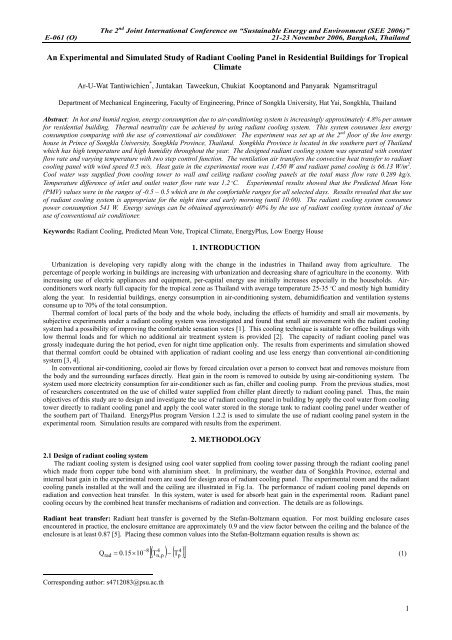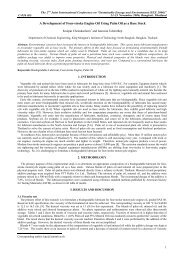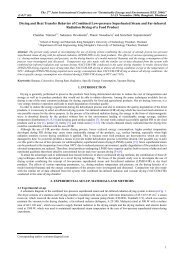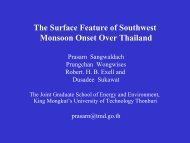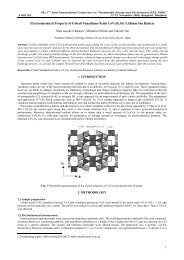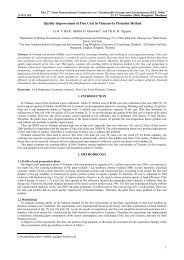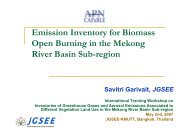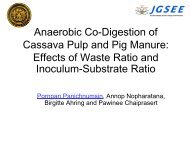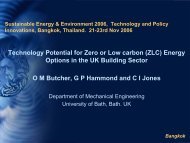An Experimental and Simulated Study of Radiant Cooling Panel in ...
An Experimental and Simulated Study of Radiant Cooling Panel in ...
An Experimental and Simulated Study of Radiant Cooling Panel in ...
Create successful ePaper yourself
Turn your PDF publications into a flip-book with our unique Google optimized e-Paper software.
The 2 nd Jo<strong>in</strong>t International Conference on “Susta<strong>in</strong>able Energy <strong>and</strong> Environment (SEE 2006)”<br />
E-061 (O) 21-23 November 2006, Bangkok, Thail<strong>and</strong><br />
<strong>An</strong> <strong>Experimental</strong> <strong>and</strong> <strong>Simulated</strong> <strong>Study</strong> <strong>of</strong> <strong>Radiant</strong> <strong>Cool<strong>in</strong>g</strong> <strong>Panel</strong> <strong>in</strong> Residential Build<strong>in</strong>gs for Tropical<br />
Climate<br />
Ar-U-Wat Tantiwichien * , Juntakan Taweekun, Chukiat Kooptanond <strong>and</strong> Panyarak Ngamsritragul<br />
Department <strong>of</strong> Mechanical Eng<strong>in</strong>eer<strong>in</strong>g, Faculty <strong>of</strong> Eng<strong>in</strong>eer<strong>in</strong>g, Pr<strong>in</strong>ce <strong>of</strong> Songkla University, Hat Yai, Songkhla, Thail<strong>and</strong><br />
Abstract: In hot <strong>and</strong> humid region, energy consumption due to air-condition<strong>in</strong>g system is <strong>in</strong>creas<strong>in</strong>gly approximately 4.8% per annum<br />
for residential build<strong>in</strong>g. Thermal neutrality can be achieved by us<strong>in</strong>g radiant cool<strong>in</strong>g system. This system consumes less energy<br />
consumption compar<strong>in</strong>g with the use <strong>of</strong> conventional air conditioner. The experiment was set up at the 2 nd floor <strong>of</strong> the low energy<br />
house <strong>in</strong> Pr<strong>in</strong>ce <strong>of</strong> Songkla University, Songkhla Prov<strong>in</strong>ce, Thail<strong>and</strong>. Songkhla Prov<strong>in</strong>ce is located <strong>in</strong> the southern part <strong>of</strong> Thail<strong>and</strong><br />
which has high temperature <strong>and</strong> high humidity throughout the year. The designed radiant cool<strong>in</strong>g system was operated with constant<br />
flow rate <strong>and</strong> vary<strong>in</strong>g temperature with two step control function. The ventilation air transfers the convective heat transfer to radiant<br />
cool<strong>in</strong>g panel with w<strong>in</strong>d speed 0.5 m/s. Heat ga<strong>in</strong> <strong>in</strong> the experimental room was 1,450 W <strong>and</strong> radiant panel cool<strong>in</strong>g is 66.13 W/m 2 .<br />
Cool water was supplied from cool<strong>in</strong>g tower to wall <strong>and</strong> ceil<strong>in</strong>g radiant cool<strong>in</strong>g panels at the total mass flow rate 0.289 kg/s.<br />
Temperature difference <strong>of</strong> <strong>in</strong>let <strong>and</strong> outlet water flow rate was 1.2 ๐ C. <strong>Experimental</strong> results showed that the Predicted Mean Vote<br />
(PMV) values were <strong>in</strong> the ranges <strong>of</strong> -0.5 – 0.5 which are <strong>in</strong> the comfortable ranges for all selected days. Results revealed that the use<br />
<strong>of</strong> radiant cool<strong>in</strong>g system is appropriate for the night time <strong>and</strong> early morn<strong>in</strong>g (until 10:00). The radiant cool<strong>in</strong>g system consumes<br />
power consumption 541 W. Energy sav<strong>in</strong>gs can be obta<strong>in</strong>ed approximately 40% by the use <strong>of</strong> radiant cool<strong>in</strong>g system <strong>in</strong>stead <strong>of</strong> the<br />
use <strong>of</strong> conventional air conditioner.<br />
Keywords: <strong>Radiant</strong> <strong>Cool<strong>in</strong>g</strong>, Predicted Mean Vote, Tropical Climate, EnergyPlus, Low Energy House<br />
1. INTRODUCTION<br />
Urbanization is develop<strong>in</strong>g very rapidly along with the change <strong>in</strong> the <strong>in</strong>dustries <strong>in</strong> Thail<strong>and</strong> away from agriculture. The<br />
percentage <strong>of</strong> people work<strong>in</strong>g <strong>in</strong> build<strong>in</strong>gs are <strong>in</strong>creas<strong>in</strong>g with urbanization <strong>and</strong> decreas<strong>in</strong>g share <strong>of</strong> agriculture <strong>in</strong> the economy. With<br />
<strong>in</strong>creas<strong>in</strong>g use <strong>of</strong> electric appliances <strong>and</strong> equipment, per-capital energy use <strong>in</strong>itially <strong>in</strong>creases especially <strong>in</strong> the households. Airconditioners<br />
work nearly full capacity for the tropical zone as Thail<strong>and</strong> with average temperature 25-35 ๐ C <strong>and</strong> mostly high humidity<br />
along the year. In residential build<strong>in</strong>gs, energy consumption <strong>in</strong> air-condition<strong>in</strong>g system, dehumidification <strong>and</strong> ventilation systems<br />
consume up to 70% <strong>of</strong> the total consumption.<br />
Thermal comfort <strong>of</strong> local parts <strong>of</strong> the body <strong>and</strong> the whole body, <strong>in</strong>clud<strong>in</strong>g the effects <strong>of</strong> humidity <strong>and</strong> small air movements, by<br />
subjective experiments under a radiant cool<strong>in</strong>g system was <strong>in</strong>vestigated <strong>and</strong> found that small air movement with the radiant cool<strong>in</strong>g<br />
system had a possibility <strong>of</strong> improv<strong>in</strong>g the comfortable sensation votes [1]. This cool<strong>in</strong>g technique is suitable for <strong>of</strong>fice build<strong>in</strong>gs with<br />
low thermal loads <strong>and</strong> for which no additional air treatment system is provided [2]. The capacity <strong>of</strong> radiant cool<strong>in</strong>g panel was<br />
grossly <strong>in</strong>adequate dur<strong>in</strong>g the hot period, even for night time application only. The results from experiments <strong>and</strong> simulation showed<br />
that thermal comfort could be obta<strong>in</strong>ed with application <strong>of</strong> radiant cool<strong>in</strong>g <strong>and</strong> use less energy than conventional air-condition<strong>in</strong>g<br />
system [3, 4].<br />
In conventional air-condition<strong>in</strong>g, cooled air flows by forced circulation over a person to convect heat <strong>and</strong> removes moisture from<br />
the body <strong>and</strong> the surround<strong>in</strong>g surfaces directly. Heat ga<strong>in</strong> <strong>in</strong> the room is removed to outside by us<strong>in</strong>g air-condition<strong>in</strong>g system. The<br />
system used more electricity consumption for air-conditioner such as fan, chiller <strong>and</strong> cool<strong>in</strong>g pump. From the previous studies, most<br />
<strong>of</strong> researchers concentrated on the use <strong>of</strong> chilled water supplied from chiller plant directly to radiant cool<strong>in</strong>g panel. Thus, the ma<strong>in</strong><br />
objectives <strong>of</strong> this study are to design <strong>and</strong> <strong>in</strong>vestigate the use <strong>of</strong> radiant cool<strong>in</strong>g panel <strong>in</strong> build<strong>in</strong>g by apply the cool water from cool<strong>in</strong>g<br />
tower directly to radiant cool<strong>in</strong>g panel <strong>and</strong> apply the cool water stored <strong>in</strong> the storage tank to radiant cool<strong>in</strong>g panel under weather <strong>of</strong><br />
the southern part <strong>of</strong> Thail<strong>and</strong>. EnergyPlus program Version 1.2.2 is used to simulate the use <strong>of</strong> radiant cool<strong>in</strong>g panel system <strong>in</strong> the<br />
experimental room. Simulation results are compared with results from the experiment.<br />
2. METHODOLOGY<br />
2.1 Design <strong>of</strong> radiant cool<strong>in</strong>g system<br />
The radiant cool<strong>in</strong>g system is designed us<strong>in</strong>g cool water supplied from cool<strong>in</strong>g tower pass<strong>in</strong>g through the radiant cool<strong>in</strong>g panel<br />
which made from copper tube bond with alum<strong>in</strong>ium sheet. In prelim<strong>in</strong>ary, the weather data <strong>of</strong> Songkhla Prov<strong>in</strong>ce, external <strong>and</strong><br />
<strong>in</strong>ternal heat ga<strong>in</strong> <strong>in</strong> the experimental room are used for design area <strong>of</strong> radiant cool<strong>in</strong>g panel. The experimental room <strong>and</strong> the radiant<br />
cool<strong>in</strong>g panels <strong>in</strong>stalled at the wall <strong>and</strong> the ceil<strong>in</strong>g are illustrated <strong>in</strong> Fig.1a. The performance <strong>of</strong> radiant cool<strong>in</strong>g panel depends on<br />
radiation <strong>and</strong> convection heat transfer. In this system, water is used for absorb heat ga<strong>in</strong> <strong>in</strong> the experimental room. <strong>Radiant</strong> panel<br />
cool<strong>in</strong>g occurs by the comb<strong>in</strong>ed heat transfer mechanisms <strong>of</strong> radiation <strong>and</strong> convection. The details are as follow<strong>in</strong>gs.<br />
<strong>Radiant</strong> heat transfer: <strong>Radiant</strong> heat transfer is governed by the Stefan-Boltzmann equation. For most build<strong>in</strong>g enclosure cases<br />
encountered <strong>in</strong> practice, the enclosure emittance are approximately 0.9 <strong>and</strong> the view factor between the ceil<strong>in</strong>g <strong>and</strong> the balance <strong>of</strong> the<br />
enclosure is at least 0.87 [5]. Plac<strong>in</strong>g these common values <strong>in</strong>to the Stefan-Boltzmann equation results is shown as:<br />
Q<br />
rad<br />
= 0.15×<br />
10<br />
−8<br />
[( T ) − ( T )]<br />
4<br />
4<br />
n, p<br />
p<br />
(1)<br />
Correspond<strong>in</strong>g author: s4712083@psu.ac.th<br />
1
The 2 nd Jo<strong>in</strong>t International Conference on “Susta<strong>in</strong>able Energy <strong>and</strong> Environment (SEE 2006)”<br />
E-061 (O) 21-23 November 2006, Bangkok, Thail<strong>and</strong><br />
where Q rad is radiant panel cool<strong>in</strong>g by radiation, T n,p is average temperature <strong>of</strong> the non-radiant panel surface <strong>of</strong> the room <strong>and</strong> T p is<br />
mean panel surface temperature.<br />
Convective heat transfer: The rate <strong>of</strong> heat transfer by convection is a comb<strong>in</strong>ation <strong>of</strong> natural <strong>and</strong> forced convection. Natural<br />
convection results from the cooled air <strong>in</strong> the boundary layer just below the panels be<strong>in</strong>g displaced by warmer air <strong>in</strong> the room. This<br />
natural process can be altered or even changed to forced convection by <strong>in</strong>filtration, human activity <strong>and</strong> the mechanical ventilation<br />
systems. M<strong>in</strong> (1956) suggested that for practical panel cool<strong>in</strong>g applications without forced convection, the cool<strong>in</strong>g convective heat<br />
transfer is given by the follow<strong>in</strong>g equation [6].<br />
Q<br />
c<br />
0.31<br />
( − T ) ( T − T )<br />
= 0.31 T<br />
(2)<br />
n,p<br />
p<br />
n,p<br />
p<br />
Where Q c is radiant panel cool<strong>in</strong>g by convection (<strong>in</strong> unit <strong>of</strong> Btu/ft 2 .hr). Thus, radiant panel cool<strong>in</strong>g, Q, can be calculated by us<strong>in</strong>g the<br />
follow<strong>in</strong>g formulation:<br />
Q = Q rad + Q c (3)<br />
In this design, the mean panel surface temperature <strong>and</strong> average temperature <strong>of</strong> the non-radiant panel surface <strong>of</strong> the room were<br />
assumed to be 25 ºC (536.4 ºR) <strong>and</strong> 32 ºC (549 ºR), respectively. The calculated values <strong>of</strong> radiant <strong>and</strong> convective heat transfer <strong>of</strong><br />
radiant cool<strong>in</strong>g panel are 38.11 W/m 2 <strong>and</strong> 27.02 W/m 2 , respectively. Total radiant panel cool<strong>in</strong>g is 65.13 W/m 2 . Area <strong>of</strong> radiant<br />
cool<strong>in</strong>g panel, A rad , <strong>and</strong> Cool water flow rate,<br />
ṁ , are calculated us<strong>in</strong>g the follow<strong>in</strong>g equation.<br />
A rad =<br />
Q<br />
ga<strong>in</strong><br />
Q ga<strong>in</strong><br />
(4)<br />
Q<br />
.<br />
p<br />
( T − T )<br />
= mC<br />
(5)<br />
wo<br />
wi<br />
where Q ga<strong>in</strong> is heat ga<strong>in</strong> <strong>in</strong> the room, C p is Specific heat <strong>of</strong> cool water, T wo is Outlet temperature <strong>of</strong> cool water <strong>and</strong> T wi is the Inlet<br />
temperature <strong>of</strong> cool water.<br />
In the design stage, cool<strong>in</strong>g tower was assumed to produce cool water <strong>and</strong> stored <strong>in</strong> the storage tank with temperature 25 ๐ C.<br />
Pump was operated us<strong>in</strong>g solenoid valve received signal from temperature sensor <strong>in</strong> storage tank. Cool water was lift to the panel by<br />
pump to the room <strong>and</strong> circulated between cool<strong>in</strong>g tower <strong>and</strong> panel. The designed cool<strong>in</strong>g tower, storage tank <strong>and</strong> pip<strong>in</strong>g system are<br />
<strong>in</strong>stalled beside the experimental room <strong>and</strong> connected with the ceil<strong>in</strong>g <strong>and</strong> wall radiant cool<strong>in</strong>g panels as seen <strong>in</strong> Fig.1b.<br />
(a)<br />
(b)<br />
Fig. 1 Experiment room, radiant cool<strong>in</strong>g panel, cool<strong>in</strong>g tower, storage tank <strong>and</strong> pip<strong>in</strong>g system<br />
2.2 Set-up the experiment <strong>and</strong> data collection<br />
The experiment was set up at the 2 nd floor <strong>of</strong> the low energy house <strong>in</strong> Pr<strong>in</strong>ce <strong>of</strong> Songkla University. The total floor area <strong>of</strong> the<br />
experiment room is 19.25 m 2 <strong>and</strong> height 2.8 m. The opaque wall is light weight concrete with thickness 75 mm <strong>and</strong> surface coated<br />
with cement motar. Transparent wall-SMG-III is used <strong>in</strong> this study <strong>and</strong> it has ultra violet transmittance 13%, solar transmittance 32%<br />
<strong>and</strong> solar absorptance 63%. The cool<strong>in</strong>g panels are <strong>in</strong>stalled at the ceil<strong>in</strong>g <strong>and</strong> at one side <strong>of</strong> the opaque wall <strong>in</strong> the experimental<br />
room. The designed area <strong>of</strong> the ceil<strong>in</strong>g <strong>and</strong> wall radiant cool<strong>in</strong>g panels are 16.83 m 2 <strong>and</strong> 5.44 m 2 , respectively.<br />
Temperature <strong>and</strong> humidity sensors were <strong>in</strong>stalled at the <strong>in</strong>terior <strong>and</strong> exterior <strong>of</strong> the experimental room to measure the temperature<br />
<strong>and</strong> relative humidity <strong>of</strong> <strong>in</strong>terior <strong>and</strong> exterior air. Surface temperatures <strong>of</strong> opaque wall <strong>and</strong> radiant cool<strong>in</strong>g panels were measured by<br />
us<strong>in</strong>g thermocouple type K. Mean radiant temperature was also recorded us<strong>in</strong>g globe thermometer. All <strong>of</strong> these data were recorded<br />
every five m<strong>in</strong>utes us<strong>in</strong>g data logger. The <strong>in</strong>terior air speed <strong>and</strong> electricity consumption were measured us<strong>in</strong>g anemometer <strong>and</strong><br />
cont<strong>in</strong>uous power meter.<br />
2.3 EnergyPlus simulation<br />
EnergyPlus requires detailed physical description <strong>of</strong> build<strong>in</strong>g shape, orientation, composition <strong>of</strong> opaque wall, transparent wall,<br />
2
The 2 nd Jo<strong>in</strong>t International Conference on “Susta<strong>in</strong>able Energy <strong>and</strong> Environment (SEE 2006)”<br />
E-061 (O) 21-23 November 2006, Bangkok, Thail<strong>and</strong><br />
floor <strong>and</strong> ro<strong>of</strong>. Version 1.2.2 <strong>of</strong> the program is used <strong>in</strong> this study. The developed model requires details <strong>of</strong> light<strong>in</strong>g device <strong>and</strong><br />
equipment. Details <strong>of</strong> architectural plan, occupancy schedule, equipment <strong>and</strong> light<strong>in</strong>g usage schedule are also required <strong>in</strong> this model.<br />
The developed model was used with the weather data <strong>of</strong> Songkhla Prov<strong>in</strong>ce to predict PMV. Common values <strong>of</strong> parameter <strong>in</strong><br />
simulation are given <strong>in</strong> Table 1.<br />
Table 1 Values <strong>of</strong> common parameters <strong>in</strong> simulation<br />
Item Parameter Unit Value<br />
1 Internal Load W 582<br />
- Occupant W 260<br />
- Light<strong>in</strong>g W 72<br />
- Equipment W 250<br />
2 Flow Rate <strong>of</strong> Cool Water kg/s 0.289<br />
3 Area <strong>of</strong> <strong>Cool<strong>in</strong>g</strong> <strong>Panel</strong> m 2 22.26<br />
4 Interior Air Velocity m/s 0.5<br />
5 Occupancy Parameter<br />
- Metabolic Rate met 1.2<br />
- Cloth<strong>in</strong>g Insulation clo 0.5<br />
2.4 Validation <strong>of</strong> model<br />
The value <strong>of</strong> PMV obta<strong>in</strong>ed from EnergyPlus model was validated us<strong>in</strong>g experimental results.<br />
3. RESULTS AND DISCUSSION<br />
3.1 Feasibility study on the use <strong>of</strong> radiant cool<strong>in</strong>g system<br />
Weather data <strong>of</strong> Songkhla Prov<strong>in</strong>ce can be divided <strong>in</strong>to four periods as given <strong>in</strong> Table 2. It was observed that there has the<br />
highest average dry-bulb temperature <strong>in</strong> the period <strong>of</strong> 16 February–31 May. Thus, this period will be used <strong>in</strong> prelim<strong>in</strong>ary design <strong>of</strong><br />
radiant cool<strong>in</strong>g system. Figure 2 illustrates the simulation results <strong>of</strong> PMV value on 12 March 2000 which is the reference day <strong>in</strong> the<br />
period <strong>of</strong> the above mentioned. It was observed that thermal comfort can be obta<strong>in</strong>ed dur<strong>in</strong>g the night time. Dur<strong>in</strong>g the day time<br />
after 10:00, the value <strong>of</strong> PMV is more than one which is <strong>in</strong> the range <strong>of</strong> unacceptably warm. Then, this study focuses only on the<br />
night time application.<br />
Table 2 Weather climate <strong>of</strong> Songkhla Prov<strong>in</strong>ce, year 2000<br />
Period Reference Day Dry Bulb Temperature ( ๐ C )<br />
Average M<strong>in</strong> Max<br />
16 February – 31 May 12 March 29.97 23.58 38.33<br />
1 June – 15 August 8 July 29.25 26.6 33.01<br />
16 August – 31 October 23 September 27.78 24.29 36.71<br />
1 November – 15 February 5 December 27.12 21.45 33.02<br />
Source: Meteorological Department (2000)<br />
4<br />
3<br />
2<br />
PMV<br />
1<br />
0<br />
1 2 3 4 5 6 7 8 9 10 11 12 13 14 15 16 17 18 19 20 21 22 23 24<br />
-1<br />
-2<br />
Fig. 2 Simulation results <strong>of</strong> PMV values, 12 March 2000<br />
3.2 Evaluation <strong>of</strong> radiant cool<strong>in</strong>g panel temperature<br />
Interior air temperature, average opaque wall temperature <strong>and</strong> radiant cool<strong>in</strong>g panel temperature from measurement dur<strong>in</strong>g 20-21<br />
September, 2006 are shown <strong>in</strong> Fig.3. It can be seen that the temperature <strong>of</strong> <strong>in</strong>terior air drops from 27.7 °C to 25.6 °C dur<strong>in</strong>g 18:00-<br />
7:00. The temperatures <strong>of</strong> <strong>in</strong>terior air <strong>and</strong> opaque wall are slightly difference. It was also observed that the <strong>in</strong>terior air, opaque wall<br />
<strong>and</strong> radiant cool<strong>in</strong>g panel temperatures are <strong>in</strong> the same pattern which decrease dur<strong>in</strong>g 18:00-7:00 <strong>and</strong> <strong>in</strong>crease dur<strong>in</strong>g 7:00-12:00.<br />
3
The 2 nd Jo<strong>in</strong>t International Conference on “Susta<strong>in</strong>able Energy <strong>and</strong> Environment (SEE 2006)”<br />
E-061 (O) 21-23 November 2006, Bangkok, Thail<strong>and</strong><br />
30<br />
29<br />
Interior air Temp.<br />
Opaque Wall Temp.<br />
<strong>Radiant</strong> <strong>Cool<strong>in</strong>g</strong> <strong>Panel</strong> Temp.<br />
28<br />
Temperature (oC)<br />
27<br />
26<br />
25<br />
24<br />
23<br />
18:00 19:15 20:30 21:45 23:00 0:15 1:30 2:45 4:00 5:15 6:30 7:45 9:00 10:15 11:30<br />
Time<br />
Fig. 3 Interior temperature, opaque wall temperature <strong>and</strong> radiant cool<strong>in</strong>g panel temperature from measurement<br />
Accumulated storage load at the opaque wall will release heat load to the experimental room <strong>in</strong> the night time. Therefore, the<br />
<strong>in</strong>terior air temperature <strong>and</strong> opaque wall temperature are slightly difference. Meanwhile, the <strong>in</strong>terior air temperature <strong>and</strong> opaque wall<br />
temperature decrease cont<strong>in</strong>uously until 7:00 accord<strong>in</strong>g to radiant cool<strong>in</strong>g panels absorb heat ga<strong>in</strong> <strong>in</strong> the experimental room.<br />
Nevertheless, the <strong>in</strong>terior air temperature, opaque wall temperature <strong>and</strong> radiant cool<strong>in</strong>g panel temperature <strong>in</strong>crease steadily after 7:00.<br />
This is due to the effects <strong>of</strong> exterior environment i.e. temperature <strong>and</strong> relative humidity <strong>of</strong> exterior air.<br />
Figure 4 illustrates <strong>in</strong>terior temperature, mean radiant temperature <strong>and</strong> radiant cool<strong>in</strong>g panel temperature from measurement<br />
dur<strong>in</strong>g 20-21 September, 2006. There have the radiant <strong>and</strong> convective heat transfers from mean radiant temperature to radiant<br />
cool<strong>in</strong>g panel dur<strong>in</strong>g 18:00 to 23:00. The different between mean radiant temperature <strong>and</strong> radiant cool<strong>in</strong>g panel temperature is nearly<br />
zero dur<strong>in</strong>g 23:00 to 6:00. The <strong>in</strong>terior air temperature decreases <strong>in</strong> the same pattern as radiant cool<strong>in</strong>g panel temperature. The mean<br />
radiant temperatures, T r , are calculated from the follow<strong>in</strong>g equation.<br />
8 0.6<br />
4 1.10x10 V<br />
( T + 273) ) +<br />
a ( T − T )<br />
1/ 4<br />
⎡<br />
⎤<br />
Tr<br />
= ⎢ g<br />
0.4 g i ⎥ - 273 (6)<br />
⎢⎣<br />
εD<br />
⎥⎦<br />
where T g is globe temperature, V a is <strong>in</strong>terior air velocity, ε is emissivity (0.95 for black globe), D is globe diameter <strong>and</strong> T i is <strong>in</strong>terior<br />
temperature.<br />
30<br />
29<br />
Interior air Temp.<br />
Mean <strong>Radiant</strong> Temp.<br />
<strong>Radiant</strong> <strong>Cool<strong>in</strong>g</strong> <strong>Panel</strong> Temp.<br />
28<br />
Temperature (oC)<br />
27<br />
26<br />
25<br />
24<br />
23<br />
18:00 19:00 20:00 21:00 22:00 23:00 0:00 1:00 2:00 3:00 4:00 5:00 6:00 7:00<br />
Time<br />
Fig. 4 Interior temperature, mean radiant temperature <strong>and</strong> radiant cool<strong>in</strong>g panel temperature from measurement<br />
Figure 5 shows the comparison between <strong>in</strong>terior <strong>and</strong> exterior temperatures with <strong>and</strong> without radiant cool<strong>in</strong>g system. It was<br />
revealed that <strong>in</strong> the duration time <strong>of</strong> 23:00-7:00 which exterior temperature <strong>in</strong> case <strong>of</strong> with <strong>and</strong> without radiant cool<strong>in</strong>g system is<br />
rather the same. The <strong>in</strong>terior temperature <strong>of</strong> the experimental room <strong>in</strong> case <strong>of</strong> with radiant cool<strong>in</strong>g system has lower temperature<br />
compar<strong>in</strong>g with the case <strong>of</strong> without radiant cool<strong>in</strong>g system.<br />
4
The 2 nd Jo<strong>in</strong>t International Conference on “Susta<strong>in</strong>able Energy <strong>and</strong> Environment (SEE 2006)”<br />
E-061 (O) 21-23 November 2006, Bangkok, Thail<strong>and</strong><br />
32<br />
30<br />
Ti-without radiant<br />
Ti-with radiant<br />
Tex-without radiant<br />
Tex-with radiant<br />
28<br />
26<br />
24<br />
22<br />
19:00 20:00 21:00 22:00 23:00 0:00 1:00 2:00 3:00 4:00 5:00 6:00 7:00<br />
Fig. 5 Comparisons between <strong>in</strong>terior <strong>and</strong> exterior temperature<br />
3.3 Thermal comfort evaluation<br />
Evaluation <strong>of</strong> thermal comfort for the use <strong>of</strong> radiant cool<strong>in</strong>g panel us<strong>in</strong>g PMV value was <strong>in</strong>vestigated <strong>and</strong> the results implied that<br />
thermal comfort can be obta<strong>in</strong>ed by us<strong>in</strong>g radiant cool<strong>in</strong>g panel <strong>in</strong> the night time. In this study, the system operated at cool water<br />
flow rate 0.289 kg/s <strong>and</strong> air speed <strong>in</strong> the experimental room was 0.5 m/s. Figure 6 illustrates the PMV values for 19 July 2006, 5<br />
August 2006 <strong>and</strong> 20 September 2006. It was observed that the PMV values are <strong>in</strong> the range <strong>of</strong> -0.5 – 0.5 which is <strong>in</strong> the comfortable<br />
range dur<strong>in</strong>g 20:00 to 10:00 for all selected days. The PMV value is more than 0.5 after 10:00 which the occupants <strong>in</strong> the<br />
experimental room feel warm. The values <strong>of</strong> PMV can be calculated us<strong>in</strong>g the follow<strong>in</strong>g formulation.<br />
PMV = [0.303 exp (-0.036M+0.028)]L (7)<br />
where M is Metabolic rate (unit <strong>in</strong> W/m 2 ) <strong>and</strong> L is imbalance between net metabolic <strong>and</strong> the rate <strong>of</strong> heat dissipation.<br />
1.5<br />
1<br />
19/7/2006 5/8/2006 20/9/2006<br />
0.5<br />
PMV<br />
0<br />
18:00 20:00 22:00 0:00 2:00 4:00 6:00 8:00 10:00 12:00<br />
-0.5<br />
-1<br />
-1.5<br />
Fig. 6 PMV values for the selected days<br />
3.4 Energy sav<strong>in</strong>g<br />
The radiant cool<strong>in</strong>g system obta<strong>in</strong>ed from the experiment consumes power consumption approximately 541.06 W. Normally, the<br />
design <strong>of</strong> split type air conditioner for the experimental room siz<strong>in</strong>g is 12,000 Btu/hr. The specification <strong>of</strong> power consumption is<br />
1,127.60 W for high energy efficient ratio (EER) air conditioner. In the comparison <strong>of</strong> the use <strong>of</strong> radiant cool<strong>in</strong>g system <strong>and</strong> the use<br />
<strong>of</strong> split type air conditioner (at 80% <strong>of</strong> specification <strong>of</strong> power consumption which is equal to 902.08 W), energy sav<strong>in</strong>gs can be<br />
obta<strong>in</strong>ed approximately 40% by the use <strong>of</strong> radiant cool<strong>in</strong>g system <strong>in</strong>stead <strong>of</strong> the use <strong>of</strong> air conditioner.<br />
3.5 Simulation results<br />
Comparisons <strong>of</strong> mean radiant temperature between simulation <strong>and</strong> experiment are given <strong>in</strong> Fig.7. It was observed that the mean<br />
radiant temperature prediction from simulation has slightly variation compar<strong>in</strong>g with the results from experiment. Figure 8 shows<br />
the comparison between simulation <strong>and</strong> experiment on 20-21 September 2006. The <strong>in</strong>put file for simulation is used with the Songkla<br />
weather data to predict PMV values. It can be seen that results from simulation is over expectation compar<strong>in</strong>g with results from the<br />
experiment.<br />
5
The 2 nd Jo<strong>in</strong>t International Conference on “Susta<strong>in</strong>able Energy <strong>and</strong> Environment (SEE 2006)”<br />
E-061 (O) 21-23 November 2006, Bangkok, Thail<strong>and</strong><br />
35<br />
Simulation<br />
Experiment<br />
Mean <strong>Radiant</strong> Temperature (oC)<br />
30<br />
25<br />
20<br />
15<br />
18:00 19:00 20:00 21:00 22:00 23:00 24:00 1:00 2:00 3:00 4:00 5:00 6:00<br />
Fig. 7 Comparisons <strong>of</strong> mean radiant temperature between simulation <strong>and</strong> experimental, 20-21 September 2006<br />
2.0<br />
Simulation<br />
Experiment<br />
1.5<br />
1.0<br />
PMV<br />
0.5<br />
0.0<br />
18:00 20:00 22:00 0:00 2:00 4:00 6:00 8:00 10:00 12:00<br />
-0.5<br />
-1.0<br />
Fig. 8 Comparisons <strong>of</strong> PMV value between simulation <strong>and</strong> experimental<br />
4. CONCLUSION<br />
The radiant cool<strong>in</strong>g system can be applied for build<strong>in</strong>gs under the tropical climate <strong>and</strong> consumes less energy consumption<br />
compar<strong>in</strong>g with the use <strong>of</strong> air conditioner. <strong>Experimental</strong> results revealed that energy sav<strong>in</strong>g can be obta<strong>in</strong>ed approximately 40%<br />
us<strong>in</strong>g radiant cool<strong>in</strong>g system <strong>in</strong>stead <strong>of</strong> the use <strong>of</strong> air conditioner. <strong>Cool<strong>in</strong>g</strong> tower could be employed to provide cool water for radiant<br />
cool<strong>in</strong>g panels. The performance <strong>of</strong> cool<strong>in</strong>g tower was 59% <strong>and</strong> depended on the temperature <strong>and</strong> humidity <strong>of</strong> exterior air. <strong>Radiant</strong><br />
cool<strong>in</strong>g panel temperature decreased cont<strong>in</strong>uously accord<strong>in</strong>g to heat transfer between non-cool<strong>in</strong>g surface <strong>and</strong> radiant cool<strong>in</strong>g panel<br />
dur<strong>in</strong>g 18:00 to 7:00. Mean radiant temperature which is the temperature surround<strong>in</strong>g the body decreased cont<strong>in</strong>uously from 18:00<br />
<strong>and</strong> this temperature was nearly the same as temperature <strong>of</strong> radiant cool<strong>in</strong>g panel dur<strong>in</strong>g 23:00 to 7:00. Values <strong>of</strong> PMV were used to<br />
exam<strong>in</strong>e thermal comfort <strong>and</strong> found that the use <strong>of</strong> radiant cool<strong>in</strong>g system is appropriate for the night time <strong>and</strong> early morn<strong>in</strong>g.<br />
5. ACKNOWLEDGMENTS<br />
The authors gratefully acknowledge the contribution <strong>of</strong> Pr<strong>of</strong>essor Surapong Chirarattananon. Grateful acknowledgements are<br />
due to the scholarship donor, Pr<strong>in</strong>ce <strong>of</strong> Songkla University for provid<strong>in</strong>g the research scholarship.<br />
6. REFERENCES<br />
[1] Koichi, K., Noriko, K., Hiroko, H., <strong>and</strong> Sh<strong>in</strong>-ichi, T. (1999) Effect <strong>of</strong> Humidity <strong>and</strong> Small Air Movement on Thermal Comfort<br />
under a <strong>Radiant</strong> <strong>Cool<strong>in</strong>g</strong> Ceil<strong>in</strong>g by Subjective Experiments, Energy <strong>and</strong> Build<strong>in</strong>gs 30, pp.185-193.<br />
[2] Prapapong Vangtook <strong>and</strong> Surapong Chirarattananon (2004) <strong>An</strong> <strong>Experimental</strong> Investigation <strong>of</strong> Thermal Comfort from<br />
Application <strong>of</strong> <strong>Radiant</strong> <strong>Cool<strong>in</strong>g</strong> <strong>in</strong> Thail<strong>and</strong>, The Jo<strong>in</strong>t International Conference on Susta<strong>in</strong>able Energy <strong>and</strong> Environment (SEE),<br />
1-3 December 2004, Hua H<strong>in</strong>, pp. 512-520.<br />
[3] Yamtraipat, N., Khedari, J. <strong>and</strong> Hirunlabh, J. (2005) Thermal comfort st<strong>and</strong>ards for air conditioned build<strong>in</strong>gs <strong>in</strong> hot <strong>and</strong> humid<br />
Thail<strong>and</strong> consider<strong>in</strong>g additional factors <strong>of</strong> acclimatization <strong>and</strong> education level, Solar Energy 78, pp. 504-517.<br />
[4] Ar-U-Wat T., Juntakan T., Chukiat K., Panyarak N. (2005) Development <strong>of</strong> Use <strong>of</strong> <strong>Radiant</strong> <strong>Cool<strong>in</strong>g</strong> <strong>Panel</strong> for Passive <strong>Cool<strong>in</strong>g</strong><br />
<strong>in</strong> Build<strong>in</strong>gs, 19th ME-Nett, Phuket, October 2005.<br />
[5] ASHRAE (1996) ASHRAE H<strong>and</strong>book-HVAC systems <strong>and</strong> equipment, Atlanta: American Society <strong>of</strong> Heat<strong>in</strong>g, Refrigerat<strong>in</strong>g <strong>and</strong><br />
Air-condition<strong>in</strong>g Eng<strong>in</strong>eer<strong>in</strong>g, Inc.<br />
[6] M<strong>in</strong>, T.C., Schutrum, L.F., Parmelee, G.V., <strong>and</strong> Vouris, J.D. (1956) Natural Convection <strong>and</strong> Radiation <strong>in</strong> a <strong>Panel</strong> Heated Room,<br />
ASHRAE Transactions 62,pp. 237.<br />
6


